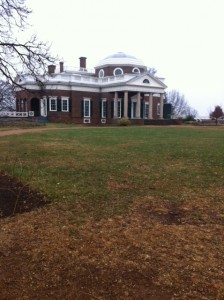
Monticello, Thomas Jefferson”s home, is just outside Charlottesville and can be reached by a hiking trail. Photo by Clark Norton
Dear Readers,
While I’m traveling in Antarctica for a few weeks I’ll be reprising some of my most popular posts from the past three years. This one (now slightly updated) originally ran in October of 2014.
After my first visit to Charlottesville, Virginia, I wrote about ten things I learned about this lovely Virginia city where my daughter now lives.
And now, after a second visit, I’ve compiled a list of five more things I learned about “C’Ville.” So I guess I’m making progress. (Stay tuned next year for “One or Two More Things I Didn’t Know About Charlottesville.”)
You could call this the “sports and outdoor activities” edition of the things I didn’t know. It was warmer for this visit than the last, so I got outside more, including to a University of Virginia night football game, a victory that came complete with exploding scoreboard every time UVA scored, enough cheerleaders and band members to fill a small town, and a prancing horse that made a dramatic entrance before each half.
So here is my new list of Five Things:
1. In Charlottesville, you can yell “Go Hoos” and no one will look askance. While the University of Virginia sports teams are officially known as the Cavaliers — and a fellow dressed up as a cavalier rides the prancing horse mentioned above — most everyone rooting for UVA yells “Go Hoos” rather than “Go Cavaliers.” “Hoos,” it turns out, is short for “Wahoos,” so some cheers are lengthened to “Wahoo-Wa!”
What’s a wahoo? Well, it’s a type of tropical fish that makes for very good eating (in Hawaii, where I’ve had it most, it’s known as ono), but that doesn’t seem to directly apply to a football team.
So in this context a “wahoo” is a UVA student, alum or member of a UVA sports team. But how did it originate?
Apparently it dates back at least to the late 19th century, when UVA students were derisively called wahoos by a rival college, and then adopted the name for themselves — perhaps because the wahoo fish is purported to be able to drink twice its body weight, an undergrad’s dream. So there is a fish connection after all.
Go Hoos!
2. You can go curling in Charlottesville. Yes, the national pastime of Canada and North Dakota, which surfaces in world consciousness every four years in the Winter Olympics, has an ice rink on its main pedestrian street that includes curling sheets — as in sheets of ice — complete with those large marked circles known as “houses” that curlers push the heavy granite stones (“rocks”) into. Seeing a curling sheet for the first time, I was surprised by how long they are — around 150 feet. (The distance seems to be compressed by TV cameras.)
I gained a new appreciation for the sweepers — those folks who sweep the ice in front of the rock as it makes its way to the target house, magically seeming to slow or speed up the rock as they go — folks I always thought were the most unlikely of Olympians. (I’ve fantasized about taking up curling sweeping myself just to make the Olympics, though I’d probably have to move to Jamaica.)
But at those distances, the sweeping can’t be all that easy a task.
I learned about Charlottesville’s curling rink because I met a medical student from North Dakota who belongs to a curling team called Three Sweeps to the Wind. It’s at the Main Street Arena, where you can also go ice skating or play hockey. I don’t associate those sports with Virginia, but then I didn’t associate wahoos with Virginia, either.
3. You can watch polo in Charlottesville, or at least nearby in Crozet, at the King Family Vineyard, which hosts matches on its polo field each Sunday afternoon (weather permitting) from Memorial Day to mid-October. The setting is both bucolic and appropriate, since polo is known as the Sport of Kings. And the King Family Vineyard has even produced a wine called “7,” which refers to the seventh chukker (six chukkers constitute a match), similar to golf’s 19th hole, which, of course, involves drinking.
Speaking of which, tailgating is encouraged before the matches, which are free — a great way to both draw people to the winery and get them to buy a bottle of wine, as well.
4. In Charlottesville, you can hike to a World Heritage Site. The site is Monticello, Thomas Jefferson’s estate, where the third president of the U.S. spent much of his life and developed many of his ideas and inventions.
The three- to four-mile round trip hike starts off Highways 20 or 53 and meanders through a hardwood forest, gradually gaining elevation until reaching the Monticello Visitor’s Center. (“Monticello” is Italian for “little mountain” and along the way you pass “Montalto,” or high mountain.) The path consists both of pea gravel and boardwalks, and is thoroughly delightful. There are also several other adjoining trails in the area as well.
5. For a really long hike in Charlottesville, take the Rivanna Trail, which circumnavigates the city, roughly following the path of the Rivanna River and a couple of creeks and taking advantage of local green spaces. At least some portions of it are paved and handicapped accessible.
I haven’t taken this trail, and it seems to have a number of sections closed periodically (requiring detours), but as best as I can figure, the entire route runs around 20 miles long. I’d be interested in hearing from anyone who has walked or run the whole trail, either in sections or all at once.
Travel Tip of the Day: For more information about Charlottesville, visit the Charlottesville Albemarle Convention & Visitors Bureau website.












2 Responses to More Things I Learned About Charlottesville, VA